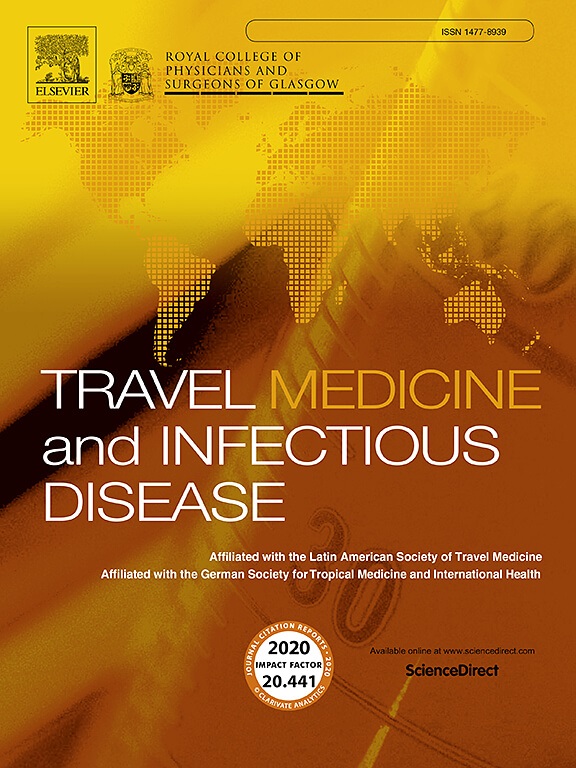Serodiagnosis of strongyloidiasis in a low-endemic setting – a two-tiered test approach
IF 4.7
3区 医学
Q1 INFECTIOUS DISEASES
引用次数: 0
Abstract
Background
Previous studies have demonstrated that Strongyloides ELISAs frequently exhibit cross-reactivity with infections caused by other helminths. This may result in false-positive results, especially in low-endemic areas, potentially leading to unwarranted treatment. This study aimed to present a new Western blot for the detection of anti-Strongyloides antibodies such as to enhance the accuracy of distinguishing true-positive from false-positive ELISA results.
Methods
We developed and validated a Western blot to detect anti-S. stercoralis specific antibodies using reference sera from confirmed cases (n = 55), non-infected control patients (n = 20), and patients with other helminth infections (n = 50). Using this sample set, we evaluated the analytical performance of three serologic approaches: an in-house ELISA, the commercially available Bordier-ELISA, and a two-tiered testing procedure combining the in-house ELISA with a confirmatory Western blot. Using receiver operating characteristics (ROC) analysis, setting-specific cut-offs values were determined for both ELISA assays. Further, we conducted a retrospective cohort study using serum samples from solid organ transplant (SOT) candidates (n = 310) tested by ELISA during pre-transplant evaluations at Bern University Hospital (2018–2022).
Results
The Western blot specifically detected human IgG antibodies against S. stercoralis. A two-tier test algorithm (in-house ELISA, followed by confirmatory Western blot) showed a diagnostic sensitivity of 96.4 % (95 %CI:87.5 %–99.6 %) and a diagnostic specificity of 98.6 % (95 %CI:92.3 %–100 %). Out of 310 SOT candidates’ serum samples, 9.3 % (n = 29) exhibited positive, and 5.2 % (n = 16) equivocal ELISA results. Testing by Western blot revealed positive S. stercoralis findings for 11.1 % (n = 5) of these patients. Two of those were initially positive and 3 were equivocal by ELISA.
Conclusions
The new Western blot is a promising tool for clarifying equivocal S. stercoralis ELISA results, and therefore predisposed to reduce false positive Strongyloides ELISA results, especially in low-endemic regions.
在低流行环境下的圆线虫病的血清诊断——两层检测方法
以往的研究表明,类圆线虫酶联免疫吸附试验经常与其他蠕虫引起的感染表现出交叉反应性。这可能导致假阳性结果,特别是在低流行地区,可能导致不必要的治疗。本研究旨在建立一种新的Western blot检测抗类圆线虫抗体的方法,以提高ELISA检测结果的真阳性和假阳性的准确性。方法建立并验证了Western blot法检测抗s。使用确诊病例(55例)、未感染对照患者(20例)和其他蠕虫感染患者(50例)的参比血清检测粪虫特异性抗体。使用该样本集,我们评估了三种血清学方法的分析性能:内部ELISA,市售的Bordier-ELISA,以及结合内部ELISA和验证性Western blot的两层检测程序。采用受试者工作特征(ROC)分析,确定两种ELISA检测的设定特异性截止值。此外,我们进行了一项回顾性队列研究,使用了伯尔尼大学医院(2018-2022)在移植前评估期间通过ELISA检测的实体器官移植(SOT)候选者(n = 310)的血清样本。结果Western blot特异检测到人抗粪球菌IgG抗体。两层检测算法(内部ELISA,然后是验证性Western blot)显示诊断敏感性为96.4% (95% CI: 87.5% - 99.6%),诊断特异性为98.6% (95% CI: 92.3% - 100%)。在310例SOT候选血清样本中,9.3% (n = 29)表现出阳性,5.2% (n = 16)表现出模棱两可的ELISA结果。Western blot检测显示,11.1% (n = 5)患者的粪球菌阳性。其中2例最初呈阳性,3例ELISA结果不明确。结论新的Western blot是一种很有前途的工具,可以澄清模棱两可的粪球菌ELISA结果,因此易于减少假阳性的类圆线虫ELISA结果,特别是在低流行地区。
本文章由计算机程序翻译,如有差异,请以英文原文为准。
求助全文
约1分钟内获得全文
求助全文
来源期刊

Travel Medicine and Infectious Disease
PUBLIC, ENVIRONMENTAL & OCCUPATIONAL HEALTH-INFECTIOUS DISEASES
CiteScore
19.40
自引率
1.70%
发文量
211
审稿时长
49 days
期刊介绍:
Travel Medicine and Infectious Disease
Publication Scope:
Publishes original papers, reviews, and consensus papers
Primary theme: infectious disease in the context of travel medicine
Focus Areas:
Epidemiology and surveillance of travel-related illness
Prevention and treatment of travel-associated infections
Malaria prevention and treatment
Travellers' diarrhoea
Infections associated with mass gatherings
Migration-related infections
Vaccines and vaccine-preventable disease
Global policy/regulations for disease prevention and control
Practical clinical issues for travel and tropical medicine practitioners
Coverage:
Addresses areas of controversy and debate in travel medicine
Aims to inform guidelines and policy pertinent to travel medicine and the prevention of infectious disease
Publication Features:
Offers a fast peer-review process
Provides early online publication of accepted manuscripts
Aims to publish cutting-edge papers
 求助内容:
求助内容: 应助结果提醒方式:
应助结果提醒方式:


